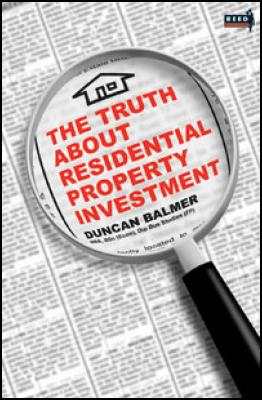Book Review: The Truth About Property Investment

Book Review: The Truth about Residential Property
Investment ,
By Duncan Balmer

The Truth about Residential Property Investment
Reviewed by Leonie Wise, Good Returns
Here's a refreshing change! A book which demonstrates that all the alleged tax benefits of property investment are either irrelevant or complete garbage, and that, in most cases, the tenant does not pay the mortgage.
In recent times where property investing seems to have become ‘the new black’, and with lots of books on how to invest in property already available, it is refreshing to read a book that covers some of the risks and hidden costs relating to property investment. This book identifies some of the disasters that can befall the uneducated property investor and is most likely going to be a real eye-opener to most readers. A person’s education with regards to property investing needs to dig deeper than just going to a couple of seminars or talking to the bloke next door who thinks it’s a sure thing. This book aims to provide an unbiased view on residential investing and remind readers that property is not always a good investment and you can go wrong with bricks and mortar and I believe it achieves this result.
In this book Balmer stresses the importance of saving money for your retirement, minimising costs and taxes, concentrating on income not growth, diversification, seeking independent advice and having realistic expectations. With regards to property investing, Balmer also considers factors such as reduced rents, high vacancy rates and increased interest rates, rents rising at less than inflation, negative gearing, long term maintenance costs, and more.
There is a chapter about real estate agents as investment advisers, that probably most of them won’t like, however it introduces the reader to an interesting piece of law called “The Investment Adviser’s (Disclosure) Act 1996” which most people have probably never heard of. Tenants also have a chapter dedicated to them, and with this being a “prepare you for the worst” type book, it does not speak favourably on the subject. It also explains gearing versus rental income - why most tenants don’t actually pay the mortgage, despite this being a popular catch-phrase at present.
While the uncertainties and risks associated with residential property investment are real and are the main subject of this book, Balmer also acknowledges that he is not so foolish as to claim that residential property is always a bad investment and there is a whole chapter dedicated to the argument for property investing.
Alternatives to property investing such as bank term deposits, portfolio investment, managed funds, fixed-interest securities, shares, forestry and derivatives are also covered early on in the book.
Balmer, as a financial adviser hears back regularly from clients that property investing is not all it’s cracked up to be and that they have done it in the past and are not likely to do it again. Lack of diversification seems to be common, with people investing in residential rental properties and nothing else.
This book is primarily aimed at anyone looking at purchasing residential property as an investment and anyone who is already investing in property with enough humility to realise that there is always more to learn and there are always other ways to make money. The examples relating to property calculations in the book are addressed to the “average Kiwi investor” who is usually only buying average houses in average areas, rather than being relevant to the “super-rich” investors who play in a different market altogether.
There are quite a number of figures and calculations to describe different scenarios used in some chapters of this book and it is extremely important that the reader understands what the term “Internal Rate of Return” means and how it affects their investment calculations. If the reader doesn’t have a head for numbers, some parts of this book may make their eyes glaze over. The only advice I can give them is that they should persevere with the book as the numbers are necessary. It is probably ideal to re-read some parts a few times to gain full understanding of the calculations; as I believe these need to be considered by investors in order to make a fully-informed purchasing decision. Overall, it is informative and well written with clear explanations on the issues being discussed.
I particularly like Balmer’s concluding remarks to the reader: “…However, above all else, the most important rule is that you must save some money for your retirement. Whether you choose residential property as your saving medium, or commercial property, or bank deposits, or shares, or a combination of these things, or anything else, for goodness sake DO SOMETHING!”
To buy ‘The Truth about
Residential Property Investment’ priced at $24.99 GST incl
from Good Returns click here.



 Gordon Campbell: On Budget 2025
Gordon Campbell: On Budget 2025 Keith Rankin: Using Cuba 1962 To Explain Trump's Brinkmanship
Keith Rankin: Using Cuba 1962 To Explain Trump's Brinkmanship Binoy Kampmark: The Killing Of Israeli Embassy Staffers - Netanyahu’s Antisemitism Canard
Binoy Kampmark: The Killing Of Israeli Embassy Staffers - Netanyahu’s Antisemitism Canard Keith Rankin: Zero-Sum Fiscal Narratives
Keith Rankin: Zero-Sum Fiscal Narratives Eugene Doyle: Chinese Jet Shoots Down France’s Best Fighter; NZ And Australia Should Pay Attention
Eugene Doyle: Chinese Jet Shoots Down France’s Best Fighter; NZ And Australia Should Pay Attention Ian Powell: “I Can Confirm They Are Hypotheticals Drawn Largely From Anecdotes And Issues The Minister Has Heard About.”
Ian Powell: “I Can Confirm They Are Hypotheticals Drawn Largely From Anecdotes And Issues The Minister Has Heard About.”